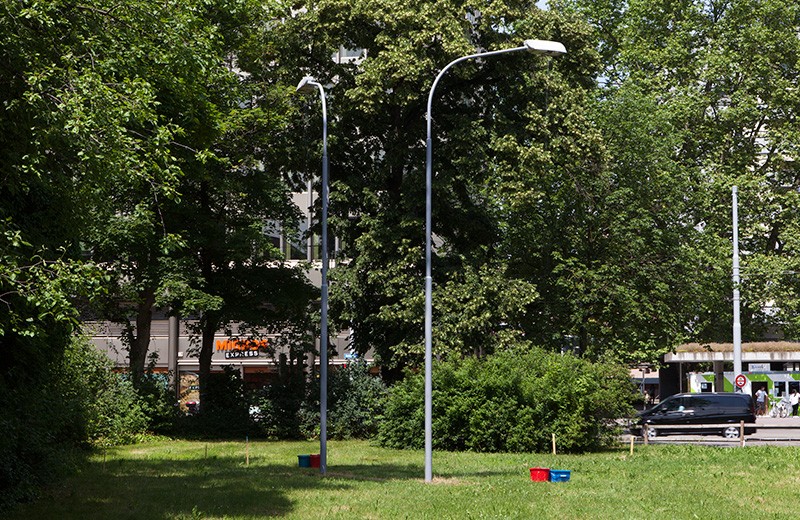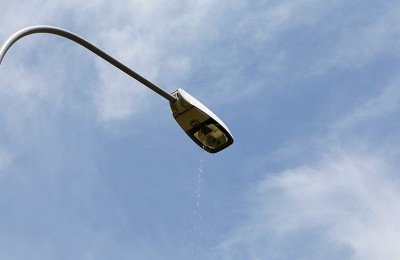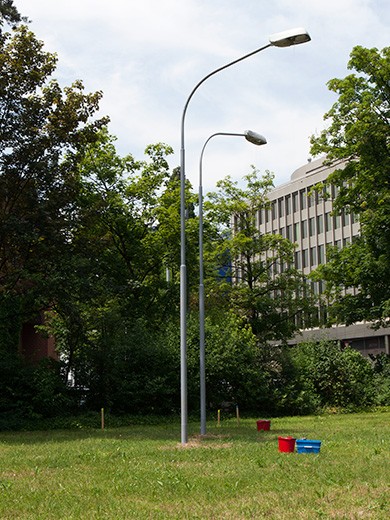Florian Graf
Light Shower, 2014/2015

Es könnte eine Szene aus Jacques Tatis Film Playtime von 1967 sein, ein parodistischer Kommentar auf das Bedürfnis nach Kontrolle und Planbarkeit bis in die urbanistischen Randzonen hinein. Im komplexen Leitungssystem der Stadt scheint ein Anschluss falsch verlegt: Statt Licht fällt Wasser von den Strassenlampen auf den Boden. Alltägliche und der Sicherheit dienende Objekte des öffentlichen Raumes fungieren plötzlich als Einrichtung aus dem intimen Wohnbereich und machen aus einem Stück Strasse ein öffentliches Duschzimmer. Die Auffangbecken unter dem doppelten Wasserfall können dem Malheur nur notdürftig entgegenwirken.
Aus der Irritation entsteht eine Insel, die den von Effizienzstreben geprägten Stadtraum zu einer Zone des unerwarteten Verweilens und des absichtslosen Spiels im situationistischen Sinn erklärt. Dem Klang von Hektik und Strassenverkehr ist das Plätschern des Wassers entgegengesetzt, anstelle gleissender Scheinwerfer der Aufklärung gibt es dunklere Zonen der Verwirrung, in denen Glühwürmchen auftauchen. Der menschlichen Torheit sei Dank – im Sinne Erasmus’, der ein Lob auf die Torheit verfasste. Und natürlich auch der Stadt Zürich, die der Kunst im öffentlichen Raum und der Kraft der Bilder die Kompetenz zu Neuordnung und Hoffnung anvertraut.
Florian Graf (*1980, CH) bewegt sich wie ein Flaneur durch die Stadt und die Welt und -übersetzt seine Beobachtungen zu den Wechselwirkungen zwischen Architektur und sozialen Situationen in vielschichtige und andeutungsreiche Bilder. Das Interesse des Architekten und Künstlers an Raum, an dessen psychologischen, atmosphärischen und politischen Dimensionen, findet poetischen Niederschlag. Scheinbar klare, minimale Formen und Eingriffe entfalten eine narrative Dichte. So verknüpft etwa die Arbeit Ghost Light Light House von 2012, ein als Floss umherirrender Leuchtturm, die Reflexion über die Geschichte der Architektur in den 1930er Jahren mit Fragen zu Migration, Überwachung und Orientierung, aber auch zur Rolle des Künstlers. Es geht um Lebens- und Gesellschaftsmodelle in einer Zeit, in der die Ausleuchtung des hintersten Winkels mit Flutlicht und Navigationsgerät gesteigerte Lebensqualität behauptet, aber Totalitäres bewirkt und das Paradies zur Hölle macht.
Wesentlich ist zudem die Textebene. Den Wortspielereien von Florian Graf wohnt ein eigener Geist inne. Be, leave in Bellelay unterstützt und destabilisiert den barocken Kirchenraum, Le Jeu Du Champ in Bex referiert unmittelbar auf Marcel Duchamp. Und mit Light Shower wird Licht zum leichten Schauer. Ursula Badrutt
Courtesy the artist und Grieder Contemporary, Zürich
English Version
It could be a scene from Jacques Tati’s 1967 film Playtime, a parodic comment on the desire for control and planability, extending out to urbanist border zones. In the city’s complex system of conduits, it seems that a connection has been installed incorrectly: instead of light, water falls to the ground from the street lamps. Objects pertaining to the public space that are taken for granted and serve to provide safety, suddenly behave like fittings from the intimate sphere of the home, turning part of a street into a public shower room. The collecting vessels beneath the double waterfall can only counteract the mishap to a meagre extent.
The irritation gives rise to an island that declares the urban space (characterised by an aspiration for efficiency) to be a zone of unexpected lingering and unintentional play, in a situationist sense. The noise and hectic nature of road traffic is contrasted with the splashing of water. Instead of the blazing searchlights of enlightenment, there are darker zones of confusion, in which glow worms appear. All thanks to human folly – as understood by Erasmus, who wrote In Praise of Folly – and of course to the City of Zurich, which entrusts art in public spaces and the power of images with the capacity for reshaping and hope.
Florian Graf (b. 1980, Switzerland) moves through the city and the world like a flaneur, translating his observations of interactions between architecture and social -situations into multifaceted and highly allusive images. This architect and artist has an interest in space, in its psychological, atmospheric and political dimensions – an interest that manifests itself poetically. Ostensibly clear minimalist forms and interventions reveal a narrative density. For instance, the 2012 work Ghost Light Light House, a lighthouse drifting around on a raft, links reflection on the history of architecture in the 1930s with issues of migration, super-vision and orientation, as well as the role of the artist. This is about lifestyle models and societal models in an era when the illumination of the furthest corner with floodlights and navigation devices purports to be enhancing the quality of life, but has a totalitarian effect and turns paradise into hell.
The textual level is also important. Florian Graf’s wordplay has an inherent spirit of its own. Be, leave in Bellelay supports and destabilises the baroque church interior, Le Jeu Du Champ in Bex indirectly refers to Marcel Duchamp and Light Shower turns a light into a light shower. Ursula Badrutt
Courtesy of the artist and Grieder Contemporary, Zurich


